Papers by Regina Palma-Dibb
Indian Journal of Dental Research
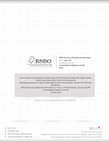
RSBO, Dec 13, 2013
Introduction and objective: The aim of this study was to assess the surface and the substrate/gla... more Introduction and objective: The aim of this study was to assess the surface and the substrate/glass ionomer cement (GIC) interface after Er:YAG laser irradiation by means of scanning electron microcopy. Material and methods: Thirty human third molars were selected and had their roots removed. Crowns were sectioned to obtain discs that were randomly assigned to three groups according to the surface pretreatment: 40% polyacrylic acid (control); Er:YAG laser irradiation (80mJ/2Hz) or Er:YAG laser followed by 40% polyacrylic acid. Two discs of each group were put aside to the surface analysis and the others were bisected. One half received Ketac-Fil and the other received Fuji II LC. Specimens were prepared for SEM and were analyzed under different magnifications. Results: Er:YAG laser group showed no adhesive interface for both enamel and dentin, but strongly damaged the interface build-up for dentin/Fuji II LC. The application of laser irradiation followed by the polyacrylic acid exhibited gaps and irregularities for both substrates. Conclusion: Er:YAG laser irradiation combined or not with 40% polyacrylic acid produced a surface unfavorable for GIC interaction, especially for the resin-modified ones.

Clinical Plasma Medicine
Abstract The aim of this study was to evaluate color change, mineral composition and topography o... more Abstract The aim of this study was to evaluate color change, mineral composition and topography of the enamel after the pre-treatment with non-thermal atmospheric plasma (NTAP) followed by 38% hydrogen peroxide (HP) bleaching. Buccal enamel of bovine incisors teeth was stained with black tea solution and then divided into five groups (n = 12), according to the plasma application time: PL1 (one minute) or PL2 (2 min) and number of HP applications: HP1 (one) and HP3 (three). The following groups were investigated: HP3, PL1+HP1, PL1+HP3, PL2+HP1 and PL2+HP3. Four color measurements: initial (untreated), after staining and after bleaching (first and second sessions), were performed using an intraoral spectrophotometer (Vita Easyshade). Energy Dispersive X-ray Spectroscopy (EDX) was used to analyze the mineral composition of the enamel before and after two bleaching sessions. Laser confocal microscopy was used to analyze the enamel topography. The pre-treatment with NTAP did not improve the whitening results. The use of NTAP preserves the concentration of calcium and phosphorus, only HP3 group experimented a significant decrease in the mineral concentration. All the bleached groups, with or without NTAP treatment increased their enamel roughness. The application of NTAP did not influence the color change, but it was important to maintain the mineral composition of bleached teeth. All the groups increased their roughness level.

American journal of dentistry, 2020
PURPOSE To evaluate the effect of different electrical brushing systems on the surface roughness ... more PURPOSE To evaluate the effect of different electrical brushing systems on the surface roughness and wear profile of the enamel of sound primary teeth and teeth with induced white spot lesions. METHODS 45 specimens were obtained from sound primary incisors, and the buccal surface was divided into four parts: sound enamel; enamel with white spot lesions; sound enamel with brushing; and enamel with white spot lesions and brushing. Specimens were randomly divided into three groups (n =15), according to the different brushing systems: Group 1 - Electric rotating toothbrush (Kid's Power Toothbrush - Oral B); Group 2 - Sonic electric toothbrush (Baby Sonic Toothbrush); and Group 3 - Manual toothbrush (Curaprox infantil) (control). The specimens were analyzed for surface roughness and wear profile. Data were analyzed by appropriate statistical tests, with a significance level of 5%. RESULTS Regarding the surface roughness, no significant difference was observed between the groups. Howe...

Journal of dentistry for children, 2020
Purpose: Radiation-related caries is characterized by enamel delamination near the dentinoenamel ... more Purpose: Radiation-related caries is characterized by enamel delamination near the dentinoenamel junction (DEJ). We investigated the activity and expression of the matrix metalloproteinases (MMPs) -2 and -9 in order to understand disease pathogenesis in teeth submitted or not to radiotherapy (RT). Methods: In situ zymography and immunofluorescence assays were performed to evaluate the activity and expression of MMPs -2 and -9, respectively. Twelve primary second molars were randomly assigned into two experimental subgroups: irradiated and nonirradiated. Dental fragments were exposed to radiation at a dose fraction of two Gy for five consecutive days until reaching the total dose of 60 Gy. The percentage of fluorescence in the DEJ was evaluated in three distinct regions of the tooth (cervical, cusp, and pit). The regions were photographed under fluorescence microscopy at 1.25× and 5× magnification. Results: The intensity of fluorescence per mm 2 in the DEJ was higher in the cervical ...

American journal of dentistry, 2019
PURPOSE To evaluate the influence of the Er,Cr:YSGG laser with or without the 5% fluoride varnish... more PURPOSE To evaluate the influence of the Er,Cr:YSGG laser with or without the 5% fluoride varnish on the acid resistance of dentin after erosive challenge. METHODS 36 incisors were selected and sectioned, obtaining 72 specimens of 4 mm × 4 mm and randomly divided into eight groups (n = 9). In G1: application of Er,Cr:YSGG (0.1W; 5Hz, air 55%); G2: laser (0.25W; 5Hz, air 55%); G3: fluoride varnish + laser (0.1W; 5Hz, air 55%); G4: fluoride varnish + laser (0.25W, 5Hz, air 55%); G5: fluoride varnish + laser (0.1W; 5Hz, without air); G6: fluoride varnish + laser (0.25W, 5Hz, without air); G7: fluoride varnish and G8: no treatment. When used, the laser was irradiated without water cooling, scanning mode during 10 seconds. The surface roughness data were subjected to ANOVA. For wear profile, we used Kruskal-Wallis test and Dunn post-hoc, all with α= 0.05. RESULTS The results showed no statistically significant difference when comparing the groups as regards to the surface roughness (P>...

Microscopy Research and Technique, 2021
This study evaluated the effects of four over‐the‐counter (OTC) bleaching products on the propert... more This study evaluated the effects of four over‐the‐counter (OTC) bleaching products on the properties of enamel. Extracted human molars were randomly assigned into four groups (n = 5): PD: Poladay (SDI), WG: White Teeth Global (White Teeth Global), CW: Crest3DWhite (Procter & Gamble), and HS: HiSmile (HiSmile). The hydrogen peroxide (H2O2) content in each product was analyzed via titration. Twenty teeth were sectioned into quarters, embedded in epoxy resin, and polished. Each quarter‐tooth surface was treated with one of the four beaching times: T0: control/no‐bleaching, T14: 14 days, T28: 28 days, and T56: 56 days. Materials were applied to enamel surfaces as recommended. Enamel surfaces were examined for ultramicrohardness (UMH), elastic modulus (EM), superficial roughness (Sa), and scanning electron microscopy (SEM). Ten additional teeth were used to evaluate color and degree of demineralization (DD) (n = 5). Data were statistically tested by two‐way ANOVA and Tukey's tests (α = 5%). Enamel surfaces treated with PD and WG presented UMH values significantly lower than the controls (p < .05). Elastic modulus (E) was significantly reduced at T14 and T28 for PD, and at T14 for HS (p < .05). A significant increase in Sa was observed for CW at T14 (p < .05). Color changes were observed in the PD and WG groups. Additionally, DD analysis showed significant demineralization at T56 for CW. Overall, more evident morphological alterations were observed for bleaching products with higher concentrations of H2O2 (p < .05), PD, and WG. Over‐the‐counter bleaching products containing H2O2 can significantly alter enamel properties, especially when application time is extended.
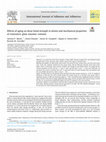
International Journal of Adhesion and Adhesives, 2020
To evaluate the shear bond strength to dentin (SBS), flexural strength (FS), and diametral tensil... more To evaluate the shear bond strength to dentin (SBS), flexural strength (FS), and diametral tensile strength (DTS) of four restorative glass ionomer cements after aging in artificial saliva. Materials and methods: For SBS testing, sound molars were ground to flat occlusal dentin and fixed with acrylic resin. Teeth were randomly divided into four groups along with the following materials: Ketac Nano, Ketac Molar, Fuji II LC and Equia. Glass ionomer cylinders were bonded to each dentin surface. For testing the mechanical properties, FS bars (25 mm � 2 mm x 2 mm) and DTS discs (4 mm � 2 mm) were fabricated. All specimens were stored in artificial saliva (37 � C) and tested after 24 h and 6 months. Data was analyzed with two-way ANOVA and post-hoc Tukey's tests (α ¼ 5%). Results: The SBS results were statistically similar among the four glass ionomer cements (p > 0.05). No significant differences in SBS after 24-h and 6-month storage were found, except for in the Ketac Nano group, where a significant decrease in SBS was found after aging (p < 0.05). All materials had a significant increase in FS after aging. The DTS values did not change significantly after aging, with the exception of the Fuji II LC group. Overall, the Fuji II LC group showed significantly higher DTS and FS compared to the other materials. Conclusions: Aging for 6 months did not affect the SBS of restorative glass ionomer cements, except in the case of Ketac Nano. All glass ionomer cements showed increased FS over time. The DTS remained unchangedexcept for the Fuji II LC, which experienced increased DTS.

Microscopy Research and Technique, 2019
The aim was to assess the effects of 1% peracetic acid (PAA) as a single endodontic irrigant on m... more The aim was to assess the effects of 1% peracetic acid (PAA) as a single endodontic irrigant on microhardness, roughness, and erosion of root canal dentin, compared with 2.5% sodium hypochlorite (NaOCl) and with 2.5% NaOCl combined with 17% EDTA. Forty human, single‐rooted tooth hemisections were submitted to Knoop microhardness test, before and after the following irrigation protocols: PAA = 1% PAA; NaOCl = 2.5% NaOCl; NaOCl‐EDTA‐NaOCl = 2.5% NaOCl +17% EDTA +2.5% NaOCl; and SS = saline. Another 40 roots were instrumented, irrigated with the same protocols, and sectioned longitudinally. The roughness analysis was performed on the mesial section using a confocal laser scanning microscope, whereas erosion was analyzed on each third of the distal section, using a scanning electron microscope. The data were analyzed using ANOVA and Tukey post‐tests, and Kruskal‐Wallis and Dunn post‐tests (α = .05). The PAA and NaOCl‐EDTA‐NaOCl groups showed no significant differences (p > .05); both promoted reduction in microhardness and increase in roughness, compared with the NaOCl and SS groups (p < .05). NaOCl‐EDTA‐NaOCl promoted higher erosion in the cervical and middle thirds than the other groups (p < .05); there was no difference among PAA, NaOCl, and SS (p > .05). There was also no difference among the groups regarding the apical third (p > .05). PAA used as a single endodontic irrigant caused reduction in root canal dentin microhardness and increase in roughness in a similar way to NaOCl‐EDTA‐NaOCl; however, PAA caused less erosion than NaOCl‐EDTA‐NaOCl.
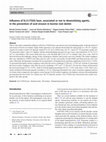
Lasers in medical science, Jan 29, 2018
This in vitro study evaluated the influence of the Er,Cr:YSGG laser, associated or not to desensi... more This in vitro study evaluated the influence of the Er,Cr:YSGG laser, associated or not to desensitizing agents, in the prevention of acid erosion in bovine root dentin. Eighty dentin specimens were selected and divided into eight groups (n = 10): G1: negative control; G2: positive control (5% fluoride varnish-FV); G3: Er,Cr:YSGG laser; G4: FV + laser; G5: 3% potassium oxalate; G6: 3% potassium oxalate + laser; G7: biphasic calcium silicate/phosphate gel (gel); G8: gel + laser. Laser parameters: 0.5 W, 6.25 J/cm at 1-mm distance. The erosive drink used was a cola soft-drink (pH = 2.42 at 4 °C), lasting 5 min, twice a day, with 6-h intervals between the challenges, during 14 days. Kolmogorov-Smirnov and Levene's tests were satisfied. The surface roughness data were submitted to ANOVA and Tukey post hoc tests. For the wear profile, Kruskal-Wallis and Dunn post hoc tests were used. Afterwards, the Spearman correlation test was performed. All statistical tests assumed a significance ...

Caries research, Jan 26, 2018
The objectives of this study were to investigate changes in the activity and expression of matrix... more The objectives of this study were to investigate changes in the activity and expression of matrix metalloproteinase (MMP)-2 and MMP-9 in permanent teeth with or without exposure to radiotherapy, and the role of proteinase inhibitors in their inactivation. In situ zymography and immunofluorescence assays were performed to evaluate the activity and expression of two key gelatinases (MMP-2 and MMP-9) in sections of permanent molars, assigned to irradiated and nonirradiated subgroups. Dental fragments were exposed to radiation at a dose of 2 Gy fractions for 5 consecutive days until a cumulative dose of 60 Gy was reached. To evaluate the effect of protease inhibitors on MMPs, teeth were immersed in 0.5 mL of 0.12% chlorhexidine digluconate (CHX), 0.05% sodium fluoride (NaF), 400 μM polyphenol epigallocatechin-3-gallate (EGCG), or distilled water (control) for 1 h. Fluorescence in the dentinoenamel junction (DEJ) was evaluated in 3 areas of the tooth: cervical, cuspal, and pit. These reg...
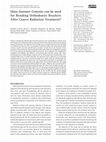
Brazilian dental journal
Patients undergoing radiotherapy treatment present more susceptibility to dental caries and the u... more Patients undergoing radiotherapy treatment present more susceptibility to dental caries and the use of an orthodontic device increases this risk factor due to biofilm accumulation around the brackets. The objective of this study was to evaluate the shear bond strength to irradiated permanent teeth of orthodontic brackets bonded with conventional glass ionomer cement and resin-modified glass ionomer cement due to the fluoride release capacity of these materials. Ninety prepared human premolars were divided into 6 groups (n=15), according to the bonding material and use or not of radiation: CR: Transbond XT composite resin; RMGIC: Fuji Ortho LC conventional glass ionomer cement; GIC: Ketac Cem Easymix resin-modified glass ionomer cement. The groups were irradiated (I) or non-irradiated (NI) prior to bracket bonding. The specimens were subjected to a fractioned radiation dose of 2 Gy over 5 consecutive days for 6 weeks. After the radiotherapy, the brackets were bonded on the specimens ...
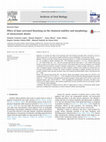
Archives of oral biology, 2018
To evaluate the effect of the bleaching with 35% hydrogen peroxide either activated or not by a 9... more To evaluate the effect of the bleaching with 35% hydrogen peroxide either activated or not by a 970nm diode laser on the chemical stability and dentin surface morphology of intracoronary dentin. Twenty-seven slabs of intracoronary dentin specimens (3×3mm) were distributed into three groups (n=9), according to surface treatment: HP - 35% hydrogen peroxide (1×4'), DL - 970nm diode laser (1×30"/0,8W/10Hz), HP+DL - 35% HP activated with 970nm diode laser (1×30"/0,8W/10Hz leaving the gel in contact to the surface for 4' after activation). Three Raman spectra from each fragment were obtained to calculate the mean intensity of peaks of inorganic component (a.u.), organic collagen content (a.u.), and the ratio of inorganic/organic content, before and after treatment. Analyses of the samples by confocal laser microscopy were performed to evaluate the surface roughness, percentage of tubules, perimeter and area percentage of tubules, before and after treatment. Data were ana...

American journal of dentistry, 2018
To evaluate the effect of ultrasonic, sonic and rotating-oscillating powered toothbrushing system... more To evaluate the effect of ultrasonic, sonic and rotating-oscillating powered toothbrushing systems on surface roughness and wear of white spot lesions and sound enamel. 40 tooth segments obtained from third molar crowns had the enamel surface divided into thirds, one of which was not subjected to toothbrushing. In the other two thirds, sound enamel and enamel with artificially induced white spot lesions were randomly assigned to four groups (n=10) : UT: ultrasonic toothbrush (Emmi-dental); ST1: sonic toothbrush (Colgate ProClinical Omron); ST2: sonic toothbrush (Sonicare Philips); and ROT: rotating-oscillating toothbrush (control) (Oral-B Professional Care Triumph 5000 with SmartGuide). The specimens were analyzed by confocal laser microscopy for surface roughness and wear. Data were analyzed statistically by paired t-tests, Kruskal-Wallis, two-way ANOVA and Tukey's post-test (α= 0.05). The different powered toothbrushing systems did not cause a significant increase in the surfa...
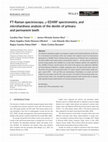
Microscopy research and technique, Jan 12, 2018
The chemical compositions (organic and inorganic contents) and mechanical behaviors of the dentin... more The chemical compositions (organic and inorganic contents) and mechanical behaviors of the dentin of permanent and deciduous teeth were analyzed and compared using X-ray fluorescence spectrometry (µ-EDXRF) Fourier transform Raman spectroscopy (FT-Raman) and a microhardness test (HD). Healthy fresh human primary and permanent molars (n = 10) were selected, The buccal surfaces facing upwards were stabilized in an acrylic plate, flattened, polished, and submitted to the µ-EDXRF, FT-Raman, and HD analysis. The results of the analysis were subjected to ANOVAs and Mann-Whitney U/Student's t multiple comparisons tests. The data showed similar values for the dentin of the primary and permanent teeth in P content, organic content (amide I peak), inorganic content ( PO43- - 430 and 590), and microhardness, Nevertheless, Ca content and Ca/P weight ratio were higher, and the CO32- peak was lower in the dentin of the permanent teeth compared to primary teeth. It be concluded that despite per...
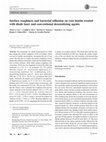
Lasers in medical science, Jan 14, 2017
The treatments for dentin hypersensitivity (DH) may change the surface roughness of the root dent... more The treatments for dentin hypersensitivity (DH) may change the surface roughness of the root dentin, which can lead to biofilm accumulation, increasing the risk of root caries. The aim was to compare the surface roughness of root dentin after different treatments of DH and the biofilm formation on those surfaces. After initial surface roughness (Sa) assessment, 50 bovine root fragments received the following treatments (n = 10): G 1-no treatment; G2-5% sodium fluoride varnish; G3-professional application of a desensitizing dentifrice; G4-toothbrushing with a desensitizing dentifrice; and G5-diode laser application (908 nm; 1.5 W, 20 s). The Sa was reevaluated after treatments. Afterward, all samples were incubated in a suspension of Streptococcus mutans at 37 °C for 24 h. The colony-forming units (CFU) were counted using a stereoscope, and the results were expressed in CFU/mL. The one-way ANOVA and the Tukey's tests compared the roughness data and the results obtained on the bac...
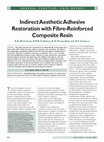
Dental Update, 2004
This paper describes the restoration of an endodontically treated upper first molar with a fibre-... more This paper describes the restoration of an endodontically treated upper first molar with a fibre-reinforced onlay indirect composite resin restoration. The clinical and radiographic examination confirmed that the tooth had suffered considerable loss of structure. Therefore, an indirect restoration was indicated. First, a core was built with resin-modified glass ionomer cement, followed by onlay preparation, mechanical/chemical gingival retraction and impression with addition-cured silicone. After the laboratory phase, the onlay was tried in, followed by adhesive bonding and occlusal adjustment. It can be concluded that fibre-reinforced aesthetic indirect composite resin restoration represented, in the present clinical case, an aesthetic and conservative treatment option. However, the use of fibres should be more extensively studied to verify the real improvement in physical and mechanical properties.
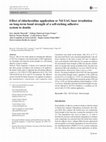
Lasers in Dental Science, 2017
Purpose This in vitro study aimed at evaluating the influence of Nd:YAG irradiation and chlorhexi... more Purpose This in vitro study aimed at evaluating the influence of Nd:YAG irradiation and chlorhexidine (CHX) application on immediate and long-term bond strength of a self-etching adhesive system to dentin. Methods Thirty fragments of dentin were randomly divided into three groups according to the treatment to be applied to the dentin surface prior to applying the self-etching adhesive system (n = 10): CHX:2% CHX application (60 s); Nd: YAG (100 mJ/20 Hz for 20 s); and NT: no treatment. The adhesive system (Clearfil SE Bond, Kuraray) was applied according to the manufacturer's instructions, and composite resin restorations were made on the dentin. After 24 h, at 37°C, the resin-tooth blocks were sectioned perpendicular to the adhesive interface in the form of sticks (0.8 mm 2 of adhesive area), and randomly subdivided into two groups according to the microtensile bond strength (μTBS) test periods: immediately or 6 months after storage in distilled water. The data were reported in MPa and submitted to two-way ANOVA for randomized blocks, followed by Tukey's test (α = 0.05). Results The group irradiated with an Nd:YAG laser presented the lowest bond strength means, regardless of the μTBS test period (24 h or 6 months) (p < 0.05). No statistical difference was observed in the μTBS means among the groups CHX and NT (p > 0.05), nor did time influence bond strength (p > 0.05). Conclusion Immediate and long-term bond strength was negatively affected by Nd:YAG irradiation, a condition not observed with 2% CHX solution application.
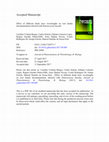
Journal of Photochemistry and Photobiology B: Biology, 2017
The objective of this study was to evaluate the antibacterial effect and the ultrastructural alte... more The objective of this study was to evaluate the antibacterial effect and the ultrastructural alterations of diode laser with different wavelengths (808nm and 970nm) and its association with irrigating solutions (2.5% sodium hypochlorite and 2% chlorhexidine) in root dentin contaminated by a five days biofilm. Thirteen uniradicular teeth were sectioned into 100 dentin intraradicular blocks. Initially, the blocks were immersed for 5 minutes in 17% EDTA and washed with distilled water for 5 minutes, then samples were sterilized for 30 minutes at 120 o C. The dentin samples were inoculated with 1 mL of E. faecalis suspension in 5mL BHI (Brain Heart Infusion) and incubated at 37 o C for 5 days. After contamination, the specimens were distributed into ten groups (n=10) according to surface treatment: GI-5 mL NaOCl 2.5%, GII-5 mL NaOCl 2.5% + 808nm diode (0.1W for 20s), GIII-5 mL NaOCl 2.5% + 970nm diode (0.5W for 4s), GIV-808nm diode (0.1W for 20s), GV-970nm diode (0.5W for 4s), GVI-CHX 2%, GVII-CHX 2% + 808nm diode (0.1W for 20s), GVIII-CHX 2% + 970nm diode (0.5W for 4s), GIX-positive control and GX-negative control. Bacterial growth was analyzed by turbidity and optical density of the growth medium by spectrophotometry (nm). Then, the specimens were processed for analysis ultrastructural changes of the dentin surface by SEM. The data was subject to the One-way ANOVA test. GI (77.5±12.1), GII (72.5±12.2), GIII (68.7±8.7), GV (68.3±8.7), GVI (62.0±5.5) and GVII (67.5±3.3) were statistically similar and statistically different from GIV (58.8±25.0), GVIII (59.2±4.0) and control groups (P<0.05). SEM analysis showed a modified amorphous organic matrix layer with melted intertubular dentin when dentin samples were irradiated with 970nm diode laser; erosion of the intertubular dentin in blocks submitted to 808nm diode laser irradiation; and a increased erosion of the intertubular dentin when 2.5% NaOCl was associated to the different wavelengths lasers. All the therapeutic protocols were able to reduce the bacterial contingent in dentin blocks, and the association of diode laser and solutions did not significantly improve the reduction of the bacterial contingent.










Uploads
Papers by Regina Palma-Dibb